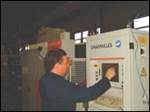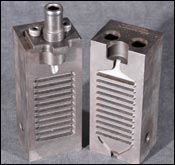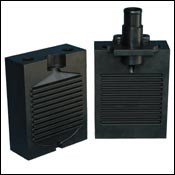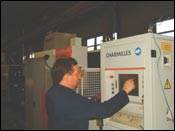Die Cast Dies: The Benefits of a Proactive Tool Build
The advantages of the two basic styles of vacuum approaches: valve and valve-less.
With the advent of a troubled auto industry and ongoing trade issues it’s no secret that the business of producing die cast parts has become increasingly competitive. There is now much less tolerance for downtime or high scrap rates. And all too often, the source of production headaches comes from porosity present within the part.
It should first be noted that every die casting tool needs air evacuation. Today, with advances that have occurred, a strong case can be made for using vacuum technology over a conventional vent system to help alleviate porosity and other die casting issues. Two basic styles of vacuum approaches currently exist: (1) valve and (2) valve-less. This article will evaluate the benefits derived from both.
Upon evaluating these advances, more and more die casters are moving from
traditional venting to the correct application of vacuum technology. Why? Because vacuum is an assistive approach that ultimately helps to create better quality parts.
Vacuum Technology
Die casters will often say the choice between conventional venting and vacuum is based on part requirement and customer preference. However, making a cost comparison before deciding might leave the customer pleasantly surprised. Consider the following benefits.
Conventional venting is less effective than vacuum because there’s not enough total vent area for the cavity to evacuate efficiently. In venting, the press alone does all of the work, whereas a vacuum system assists the press in evacuating the cavity. It’s more efficient and there’s less wear and tear on the machine and tool, saving maintenance time and costs, not to mention part fallout.
Vacuum systems reduce the amount of gas porosity in the casting. This is a major benefit because although all porosity cannot be eliminated, most of it can be with vacuum assistance.
Three different types of porosity are created during the die casting process. One is simply air in the metal feed system and die cavity. The second type is a gas that’s created when the hot metal that’s being injected hits the lubricant that’s being used. Vacuum technology helps reduce these types of porosity. The third type of porosity is shrinkage. Unfortunately, process control is a more critical factor in minimizing the problem, and vacuum technology has little influence on this.
“Vacuum vents have helped us reduce poor fill and porosity scrap rate and produce a better quality part,” reports Rod Dunn, Inverness Casting Group, (Dowagiac, MI). As for technical assistance with selecting the proper technology? “It’s been appreciated!”
Other benefits of vacuum technology include improved surface finish and improved mechanical properties of the metal being cast. Vacuum technology reduces out gassing, thereby improving painting and plating quality as it reduces the out gassing. Additionally, the higher the density of the casting, the better the weldabil-ity and leakage factors will be.
Location of porosity is critical. If air is near the surface when the parts heat up, the air will expand and could cause holes or blisters on the surface during powder coating or plating. The use of vacuum blocks means there will be less scrap because you can decrease the porosity inside the part, plus you can prevent other problems that can arrive downstream during machining.
“We had a four-cavity aluminum disk mold, where the part was simple and the initial inspection was positive,” describes Denny Schlager, Twin City Die Castings (Minneapolis, MN). “But during the machining process, grooves were cut across the face of the casting and we were experiencing a high rate of porosity at the deepest machined sections. This caused an 80 percent rejection rate!”
Twin City had to do something: “We installed two valve-less vacuum blocks. One block serviced two cavities and with the help of technicians from blocks supplier Midland Technologies, a proper runner was engineered. They also advised us in the setup and operation of the system. This improved our acceptance rate to more than 95 percent.”
In today’s competitive marketplace, where die casting is taking on more and more complexity, it’s hard to deny the advantages of using vacuum technology to increase up-time and lower costs.
Valve vs. Valve-less
Following are some notable comparisons between valve and valve-less vacuum block systems.
• Valve style blocks require moving parts; valve-less blocks have no moving parts. In a valve type system a valve of some design is required to shut off the metal flow during the shot cycle and prevent the metal from plugging the vacuum system. These are moving parts that will wear and require routine maintenance prior to, during or after the system’s use. When maintenance will be required is not fully predictable, and component parts must be inventoried to ensure the continued operation of the system. One has only to talk to a current user of valve type blocks to find out they are fairly high maintenance.
The valve-less vacuum system uses no moving parts in the metal flow path, instead it uses resistance to metal flow and the solidification of the metal to shut off the vacuum and metal flow. In addition, the blocks are heat-treated using H-13 material and cooling lines can be incorporated in the block to aid in the solidification of the metal.
• Valve styles use both the metal flow via a secondary valve or electrical switches plus a cylinder to shut off the vacuum with the valve; whereas valve-less styles pull vacuum during the complete shot cycle until the metal solidifies.
Because of their complexity, experience has shown a great deal of downtime associated with these systems, which further adds to the overall cost of the vacuum and prevents many die casters from adopting vacuum assistance as a way to improve casting quality. The simplicity of the valve-less vacuum technology is changing that mindset.
• Those moving components in a valve style block must be maintained and replaced on a routine basis; valve-less style blocks require no maintenance.
Many moving parts can make a valve style vacuum system costly to purchase and maintain. Whether limit switches, timers and/or plc is used to control the vacuum valve open-close, they are expensive to install and maintain, and are subject to failure. The more complicated the system the more likely the system will not perform in a die casting environment. Take, for example, the filters used on most systems. Filters are required to prevent the flow of gases, residue and metal from damaging the vacuum pump, secondary valves and gauges. If routine maintenance is not performed on a regular basis, in many cases the filters plug up, reducing the effectiveness of the vacuum system. A filter is available that is free flowing and does not require the amount of maintenance required in the conventional type.
The valve-less vacuum blocks are designated by size, which relates to the area available to pull the necessary evacuation. The user must determine the size vacuum area required prior to ordering the specific model of block. The calculations for determining the block size are provided by the supplier or there are computer software products available that can provide this data. Generally, the formula for determining the necessary area computes the total volume of the metal feed system—including part and fill time. There are safety factors built into the formula to ensure that the area is adequate to accomplish the evacuation of the cavity.
Valve-less vacuum blocks can be used in aluminum, zinc and magnesium die casting, and many have lasted more than 100,000 shots without repair. Complete systems including tank, pump, controls, filter and gauges are available as is design assistance.
Standardization Saves Money
Vent and vacuum technology has been around since the 1950s. Even valve-less vacuum systems are not new to die casting, but the systems had to be custom manufactured for each project. Only in 1995 did valve-less vacuum and vent blocks begin to become truly standardized. Now complete systems are available off-the-shelf, and the benefits are clear. In most cases, these standardized systems are four to five times less expensive than custom varieties, and add to that a significant savings in valuable production time.
With customer quality expectations running high, and costing pressures like never before, now more than ever die casters can benefit from evaluating these technological advances. Vacuum technology, properly applied, dramatically increases productivity and decreases scrap.
Read Next
Do-Rite Die & Engineering: Doing Right by Its Customers With Die Cast Dies
Learning the intricacies of die cast die building offers moldmakers an alternative to mold manufacturing and can generate more repeat business.
Read MoreReasons to Use Fiber Lasers for Mold Cleaning
Fiber lasers offer a simplicity, speed, control and portability, minimizing mold cleaning risks.
Read MoreHow to Use Strategic Planning Tools, Data to Manage the Human Side of Business
Q&A with Marion Wells, MMT EAB member and founder of Human Asset Management.
Read More


















